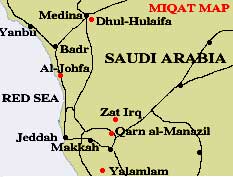 Miqat map to Makkah Al-Mukkaramah
Miqat map to Makkah Al-Mukkaramah
|
The other names of the Kaaba, are Bait ul Ateeq-which means, according to one meaning, the earliest and ancient. According to the second meaning, it means independent and liberating. Both meanings could be taken. Bait ul Haram-the honorable house. Scholars and historians say that the Kaaba has been reconstructed between five to 12 times.
Baytullah the House Of Allah
In the province of Hijaz in the western part of Saudi Arabia, not far from the Red Sea, there lies the town of Makkah. In the center of this town there is a small square building made of stones. The small, cubed building may not rival skyscrapers in height or mansions in width, but its impact on history and human beings is unmatched. Since time immemorial world travelers have known this town and this stone built house. This is Baytullah, the House of Allah. Its sanctity and antiquity is older than history itself.
|
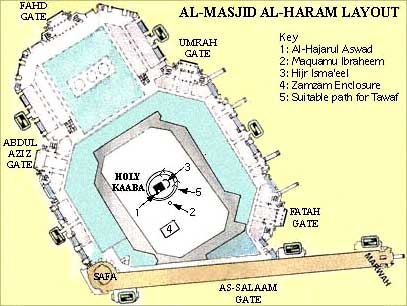 Al-Masjid Al-Haram Latest Layout
Al-Masjid Al-Haram Latest Layout
|
The Baytullah\Kaaba is the building towards which Muslims face five times a day, everyday, in prayer. This has been the case since the time of Prophet Muhammad (peace and blessings be upon him & his family) over 1400 years ago. Literally, Kaaba in Arabic means a high place with respect and prestige. The word Kaaba may also be derivative of a word meaning a cube.
The other names of the Kaaba, are Bait ul Ateeq-which means, according to one meaning, the earliest and ancient. According to the second meaning, it means independent and liberating. Both meanings could be taken. Bait ul Haram-the honorable house. Scholars and historians say that the Kaaba has been reconstructed between five to 12 times.
Tradition goes that the Kaaba was ordained by Allah to be built in the shape of the House in Heaven called Baitul Ma'amoor. Allah in his infinite Mercy ordained a similar place on earth and Prophet Adam (p.b.u.h.) was the first to build this place. The Bible, in the chapter of Genesis describes its building when God ordained Abraham (p.b.u.h.) to erect a Shrine for worship when Abraham (p.b.u.h.) was ordered to go to the southern desert with his wife Hager (p.b.u.h.) and infant son Ishmael (p.b.u.h.). The Old Testament describes this building as the Shrine of God at several places, but the one built at Ma'amoor is very much similar to the one at Makkah. There is no doubt that it was referring to the stone built house at Makkah.
|
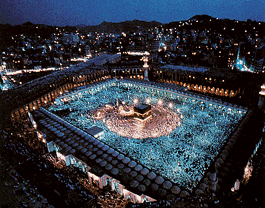 Aerial View of Ka'abah
Aerial View of Ka'abah
|
Holy Qur'an brought this story into the full light of history. Say: "Allah spoken the Truth: follow the religion of Abraham, the sane in faith; he was not of the Pagans." The first House (of worship) appointed for men was that at Bakka: Full of blessing and of guidance for all kinds of beings. (Holy Qur'an 3:95-96)
From the above verses Holy Qur'an firmly establishes the fact that Abraham (p.b.u.h.) was the real founder of the Holy Shrine.
Prophet Abraham (p.b.u.h.) built this House for devout worship to the only God. But within his lifetime people disobeyed his orders and began to put idols inside the Kaaba. Abraham (p.b.u.h.) had to clean the House of these idols and of idle worshippers. He told the people that this was a symbolic house of God. God does not live there; He is everywhere. People did not understand this logic and after the death of Abraham (p.b.u.h.), the people, out of reverence, filled the place with idols again. They thronged to this place annually and worshipped their personal gods, It was over Four Thousand years later that the last of the line of prophets.
|
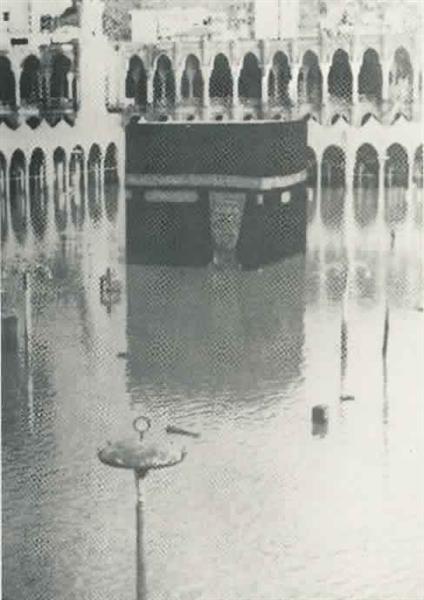 Ka'abah when flooded
Ka'abah when flooded
|
Muhammad Ibne Abdullah (p.b.u.h.) entered Makka triumphantly, went inside the Kaaba and, with the help of his cousin and son-in-law Ali Ibne Abi Talib (p.b.u.h.) destroyed all the idols of Kaaba with their own hands. At one stage of this destruction of idols, the tallest of the idol Hubbol was brought down after Ali had to stand on the shoulders of the Prophet to carry out God's orders. The Prophet of Islam (p.b.u.h.) was reciting the verse from the Holy Qur'an "Truth hath come and falsehood hath vanished". This was done in the 8th year of Hijra, January 630 AD after the bloodles victory at Makka by the Prophet of Islam (p.b.u.h.)
Historically when Abraham (p.b.u.h.) was ordered by Allah to build the Shrine for worship, he uncovered the original foundations of the Kaaba built by Adam (p.b.u.h.). Abraham (p.b.u.h.) with the help of his son Ishmael (p.b.u.h.) erected the new shrine on the same foundations. Originally it contained only four walls without a roof. Centuries later during the time of Khusayi who was the leader of the Tribe of Quraish in Makka a taller building was completed with a roof and a quadrangle wall around it to give it the shape of a sanctuary and doors all around the sanctuary walls. People entered through these doors to come to the Kaaba for worship.
|
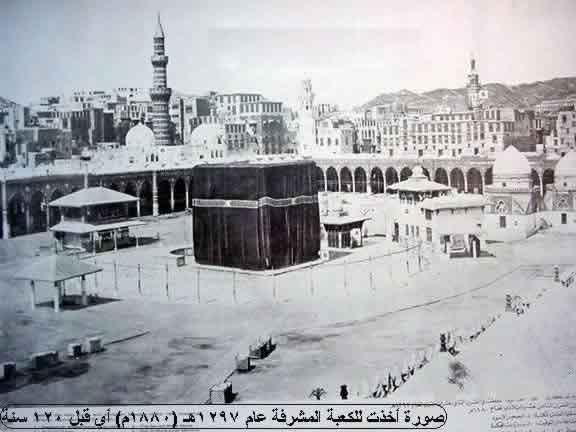 Haram in 1880 A.D.
Haram in 1880 A.D.
|
It is now about 60 feet high, 60 feet wide from east to west and 60 feet from north to south.A door is fixed about 7 feet above ground level facing Northeast. A Black stone (Hajar al-Aswad) was fixed into its eastern corner. In front of the building was Maqam-e-Ibrahim, the arch shape gate known as that of Banu Shayba and the Zamzam Well. Just outside are the Hills called Safa and Merwa and the distance between the hills is about 500 yards. These days both of the hills are enclosed into the sanctuary walls with a roof over it.
The whole building is built of the layers of gray blue stone from the hills surrounding Makka. The four corners roughly face the four points of the compass. At the East is the Rukn-e-Aswad (The Black stone), at the North is the Rukn-e-Iraqi, at the west Rukn-e-Shami and at the south Rukn-e-Yamani. The four walls are covered with a curtain (Kiswa). The kiswa is usually of black brocade with the Shahada outlined in the weave of the fabric. About 2/3rd of the way up runs a gold embroidered band covered with Qur'anic text.
In the Eastern corner about 5 feet above ground the Hajar al-Aswad (The Black stone) is fixed into the wall. Its real nature is difficult to determine, its visible shape is worn smooth by hand touching and kissing. Its diameter is around 12 inches. Opposite the Northwest wall but not connected with it, is a semi circular wall of white marble. It is 3 feet high and about 5 feet thick. This semi circular space enjoys an especial consideration and pilgrims wait in queue to find a place to pray there.
|
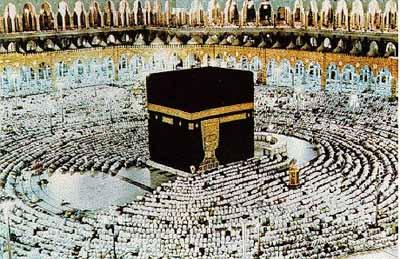 Hateem on the other side of Ka'abah
Hateem on the other side of Ka'abah
|
The graves of Ismael (p.b.u.h.) and his mother Hager (p.b.u.h.) are within this semi circular wall (Hateem). Between the archway and the facade (N.E.) is a little building with a small dome, the Maqam-e-Ibrahim. Inside it is kept a stone bearing the prints of two human feet. Prophet Abraham (p.b.u.h.) is said to have stood on this stone when building the Kaaba and marks of his feet are miraculously preserved. On the outskirts of the building to the Northeast is the 'Zamzam Well' (this is now put under ground).
|
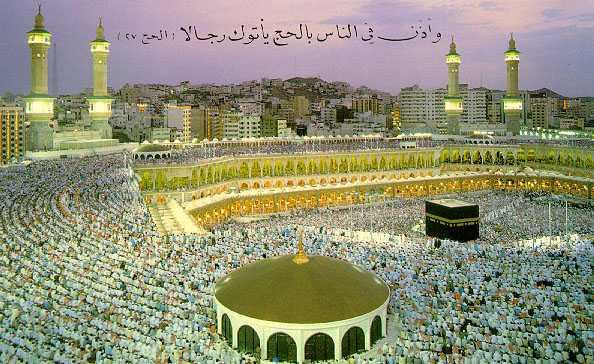 Screen Shot: Hyper Lander 2 Classic
Screen Shot: Hyper Lander 2 Classic
|
|
|
|
Pilgrimage
The fifth pillar in Islam is to perform Pilgrimage to Makkah once in a life time of each person if means allow him/her. That place was selected by Allah Himself He selected Makkah for Adam and Eve after coming from Heaven to live there. They were guided by Allah through the help of Angel Gabriel to build the first place of worship on this planet earth. That place is called Ka'aba.
Later in history, it was destroyed by flood. Allah sent Prophet Ibrahim and his son Ismail to rebuild the Ka'aba. Since that time Muslims have been instructed in the Qur'an that their pilgrimage place is Ka'aba in Makkah.
Muslims all over the world are being blessed by Allah, that Ka'aba has become a source of Unity five times a day. It is also a source of Unity during Pilgrimage (Hajj).
|
|